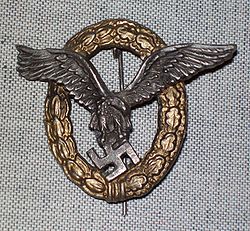Joachim Müncheberg
| Joachim Müncheberg | |
|---|---|
| Narození | 31. prosince 1918 Darskowo |
| Úmrtí | 23. března 1943 (ve věku 24 let) Meknassy |
| Příčina úmrtí | zabitý v boji |
| Povolání | stíhací pilot, pilot a atlet |
| Ocenění | Německý kříž ve zlatě Ritterkreuz des Eisernen Kreuzes mit Eichenlaub und Schwertern |
| Některá data mohou pocházet z datové položky. | |
Joachim Müncheberg (18. prosince 1918, Friedrichsdorf, Pruské království – 23. března 1943, Maknassy, Tunisko) byl stíhacím esem německé Luftwaffe za druhé světové války. Ve více než 500 bojových misí dosáhl 135 potvrzených sestřelů nepřátelských letadel. Většiny sestřelů dosáhl v bojích nad západní Evropou, 33 sestřelů dosáhl na východní frontě. Ze všech jeho vzdušných vítězství se ve 46 případech jednalo o sestřelení britských stíhaček Supermarine Spitfire. Müncheberg, který dosáhl hodnosti majora, byl za své úspěchy byl vyznamenán Rytířským křížem Železného kříže a italskou medailí Medaglia d'oro al Valore Militare.
Vyznamenání
 Rytířský kříž, I. třída (10.05.1940)
Rytířský kříž, I. třída (10.05.1940) Rytířský kříž Železného kříže (14.09.1940)
Rytířský kříž Železného kříže (14.09.1940) Rytířský kříž Železného kříže, s dubovou ratolestí, 12. držitel (07.05.1941)
Rytířský kříž Železného kříže, s dubovou ratolestí, 12. držitel (07.05.1941) Rytířský kříž Železného kříže, s dubovou ratolesti a meči, 19. držitel (09.09.1942)
Rytířský kříž Železného kříže, s dubovou ratolesti a meči, 19. držitel (09.09.1942) Rytířský kříž, II. třída (17.09.1945)
Rytířský kříž, II. třída (17.09.1945) Medaile za vojenskou statečnost[1], stříbrná (1941) (Itálie)
Medaile za vojenskou statečnost[1], stříbrná (1941) (Itálie) Německý kříž , ve zlatě (05. 06. 1942)
Německý kříž , ve zlatě (05. 06. 1942) Frontová letecká spona[2], stíhací piloti, ve zlatě s přívěskem za 400 letů
Frontová letecká spona[2], stíhací piloti, ve zlatě s přívěskem za 400 letůSpolečný odznak pro piloty a pozorovatele[3]
Reference
Externí odkazy
 Obrázky, zvuky či videa k tématu Joachim Müncheberg na Wikimedia Commons
Obrázky, zvuky či videa k tématu Joachim Müncheberg na Wikimedia Commons - Aces of the Luftwaffe [online]. [cit. 2007-04-16]. (Joachim Müncheberg). Dostupné v archivu pořízeném dne 2012-07-02.
- Adlertag [online]. [cit. 2010-01-10]. (Joachim Müncheberg). Dostupné online. (německy)
- Lexikon der Wehrmacht [online]. [cit. 2010-01-10]. (Joachim Müncheberg). Dostupné v archivu pořízeném dne 2012-01-31. (německy)
- Dariusz Tyminski. WW II Ace Stories [online]. [cit. 2010-01-10]. (Joachim Müncheberg). Dostupné v archivu pořízeném dne 2010-12-24.
- Válka.cz, major Joachim Müncheberg
Média použitá na této stránce
Ribbon bar: Iron Cross 1st Class 1935-1945 (Third Reich).
Ribbon bar: Knight's Cross of the Iron Cross (Third Reich) – version.
Ribbon bar: Knight's Cross of the Iron Cross with Oak Leaves (Third Reich) – version.
Ribbon bar: Knight's Cross of the Iron Cross with Oak Leaves and Swords (Third Reich) – version.
Ribbon bar: Iron Cross 2nd Class 1935-1945 (Third Reich).
Autor: Mboro, Licence: CC BY 3.0
Conventional ribbon bar: German Cross in Gold (3rd Reich).
Autor: KEN, Licence: CC BY-SA 3.0
German Front Flyer Clasp - 1941 (bomber)
- The Front Flying Clasp of the Luftwaffe (German: Frontflugspange) was a World War II German military decoration awarded to aircrew and certain other Luftwaffe personnel in recognition of the number of operational flights flown. It was instituted by Reichsmarschall Hermann Göring on 30 January 1941. It was awarded in Bronze, Silver, and Gold with an upgrade to include diamonds possible. Pennants suspended from the clasp indicated the number of missions obtained in a given type of aircraft.
(c) Bundesarchiv, Bild 101I-432-0760-10 / Opper / CC-BY-SA 3.0
Autor: Scargill, Licence: CC BY-SA 3.0
The Pilot/Observer Badge (German: Flugzeugführer- und Beobachterabzeichen) was a World War II German military decoration awarded to Luftwaffe service personnel who had already been awarded the Pilot's Badge and Observer Badge. It was instituted on 26 March 1936 by the Commander in Chief of the Luftwaffe Hermann Göring. It was worn on the lower part of the left breast pocket of the service tunic, underneath the Iron Cross 1st Class if awarded. It was to replace the older 1933 Aircrew Badge. The badge was originally manufactured in bronze, and later zinc. The badge can be distinguished from the Pilot's Badge by the gold wreath; the Pilot's Badge had a silver wreath. There was also a cloth version of the badge which used embroidered bullion for the officer's version and cotton for the NCO's version. The presentation case was dark blue, with a blue satin top liner and a blue velvet bottom liner on the inside.
Italian al valor militare (military valour) gold medal bar, old style










